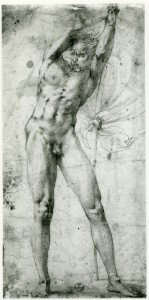1524
Florence, Uffizi, no. 6497F.
Red chalk, 41.5 x 20; the paper is stained in several places and there is a hole in the left ankle of the figure. Inscribed at the lower left: A. On the verso is an undecipherable scribble in red chalk.
LITERATURE:
Ferri, 1890, 125, as Rosso.
Berenson, 1903, no. 2427, as Rosso.
Kusenberg, 1931, 135, 141, no. 33, as Rosso, 1521-1523.
Berenson, 1938, no. 2427, as Rosso.
Barocchi, 1950, 204, Fig. 181, as Rosso, from the end of his Florentine period.
Longhi, 1951, 59 (1976, 99), as not by Rosso.
Marcucci, 1953, 87, n. 22, as by Clemente Bandinelli.
Sinibaldi, 1960-1961, 35, no. 52, as Rosso, and as perhaps executed just before his departure for Rome.
Berenson, 1961, no. 2427, as Rosso.
Carroll, 1961, 449, n. 12, 450, as by Rosso and not by Clemente Bandinelli.
Griseri, 1964, 11, as seeming to derive from Berruquete.
Carroll, 1964 (1976), I, Bk. I, 117-122, 126, 127, Bk. II, 234-236, D. 15, III, Fig. 41, as Rosso, around 1525-1526.
Annamaria Petrioli Tofani, Disegni Italiani della Galleria degli Uffizi, exh. cat., Jerusalem, 1984, no. 17, as Rosso.
Carroll, 1987, 74, n. 2, with Fig., under no. 8, as Rosso, c. 1524.
This tall, slender, tightly muscular figure is very similar to the Pluto in a Niche (Fig.D.17A; Fig.E.32) and the Vulcan in a Niche (Fig.E.44) designed by Rosso and engraved by Caraglio in 1526. The screaming head with flying hair is quite like that of one of the centaurs in Rosso’s Hercules Fighting the Centaurs of around 1524, also engraved by Caraglio (Fig.E.22). Behind the figure the billowing drapery resembles that in the Neptune in a Niche (Fig.E.30). Graphically, the drawing is close to Rosso’s study (Fig.D.7) for the figure of St. Sebastian in the Dei Altarpiece. But the draughtsmanship of the Nude with a Standard has a tightness and precision, and in the drapery a crispness, that brings to mind the Seated Woman in a Niche (Fig.D.10). Given these relationships it appears quite clear that the drawing is by Rosso, and that it was done in Rome.
However, the tightness of the drawing still relates it to Rosso’s late Florentine works rather than to such later and somewhat softer and more granular Roman drawings as the Bacchus in a Niche (Fig.D.18a) and the Pluto in a Niche (Fig.D.17A) of 1526. It is likely that the Nude with a Standard was done in 1524, around the time of the Seated Woman in a Niche. The image of the drawing and the emotion it conveys are most identifiable with Rosso’s Fury (Fig.E.18a), designed by Rosso and engraved in Rome probably in 1524. Both are very possibly among Rosso’s earliest Roman works.
Longhi, Marcucci, and Griseri did not accept the traditional attribution of this drawing to Rosso. Longhi did not suggest an alternative. Marcucci’s attribution to Clemente Bandinelli is not supported by the drawings that are attributed to him in the Uffizi nor by his sculpture.1 Neither Longhi’s refutation, nor Marcucci’s attribution, nor Griseri’s suggestion of Berruquete can stand in the face of the visual evidence that so strongly supports the attribution to Rosso.

